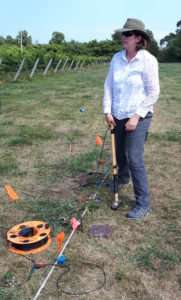Geology and grapes a winning pair

About 150 years after grapes were first cultivated on a small strip of Pelee Island, vineyards now cover two-thirds of the island and have become its major agricultural enterprise.
Today, Pelee Island Winery produces ice wines and Pinot Noirs that rival the centuries-old winemaking pedigree of the Bordeaux and Rhinegau regions.
While much credit for Pelee's remarkable success goes to the island's unique microclimate, some of its future growth may come about because of transformative soils research by Western Geology professor Patricia Corcoran and her team.
"Grapes don't grow everywhere in Canada. There are a few vineyards in the Okanagan valley, and the Niagara region, but Pelee Island is the perfect place to grow grapes because the surrounding water keeps the air above the island warmer," Corcoran said. "This ensures a longer harvest period."
During the past year, a team of geologists led by Corcoran and Earth Sciences professor Elizabeth Webb have collaborated with Bruno Friesen to fine-tune the soil management practices at renowned Pelee Island Winery.
Friesen is the vineyard manager, and one of his puzzles is why grapes don't grow as well in the easternmost part of the island.
"Bruno thinks that the grapes don't grow well on the island's east because the soils are deeper over there,' said Webb. "This summer when we looked – yes, the soils were deeper there."
But if shallow soils correlate to healthier grapevines, it opens up a new question – does the basement rock influence the soil minerals above it?
To tackle that question, Corcoran is using a fine fingerprinting technique that examines whether the proportion of the rock's rare earth elements (REEs) has changed over time through movement from its underlying tectonic plates.
"If the basement rock's REE signature matches the soil's, then we know that the basement rock is weathering into the soil," said Corcoran. 'That would confirm Bruno's hunch to fertilize a strip depending on how deep the soil is beneath it.'
A seismic survey analysis has already been performed to locate the basement rock across the vineyard.
The team is also tracking the abundance of nitrogen in the soil, and its movement between the soil and plant. Understanding this process will help guide Friesen's fertilizer practices.
Yet, the biggest mystery may be why grapes grow well here at all. Pelee Island was once a marsh, and it is unheard-of to grow grapes on clayey marsh lands. Instead, they usually prefer sandy soil.
'What makes that soil so special?' Corcoran asked.
The secret might lie in the type of clay.
"Bruno noticed that the grapes didn't grow so well in a specific region. This summer when we looked, we found that unlike the rest of the island, this region was lacking a clayey band beneath the soil. Soon, we'll have the geochemical data to go with our results," said Webb. "By treating the soil with hot water and weak acids we simulate the vine's root conditions and observe what specific elements are released from the soil," she said.
The next step would be to correlate the soil's properties with the elemental composition of the leaves – discovering, for example, whether calcium-enriched leaves grow from clay soil and if magnesium-deficient leaves are the result of shallow soil.
Understanding how soil types affect the leaf's elemental composition will inform Bruno on which grapevines will grow best in a specific region.
The island was home, in 1871, to one of Canada's earliest wineries, and grape-growing was one of its major activities until the Great War and crop disease caused the Pelee industry to wither on the vine. Six decades later, grapes were reintroduced to the island and Pelee Island Winery was born.
This novel research collaboration between Pelee Island Winery and Western University began serendipitously.
"Originally. we were not aiming to work with a winery," recounted Corcoran.
Rather, they intended to work with a fertilizer company and to inspect a carbonatite deposit in Northern Ontario.
Before the work began, though, the company owner sold the firm – but not before introducing the team to Friesen, one of his customers.
"Bruno wanted to know how geology affects the types of plants you grow,' Corcoran said.
Provided by University of Western Ontario




















